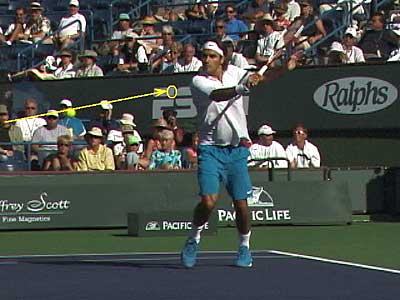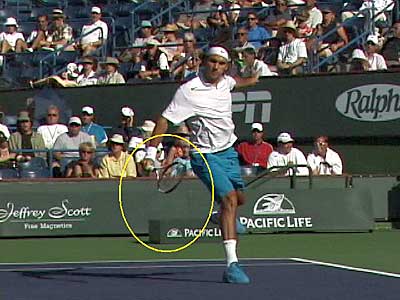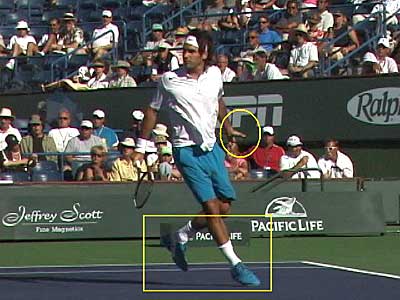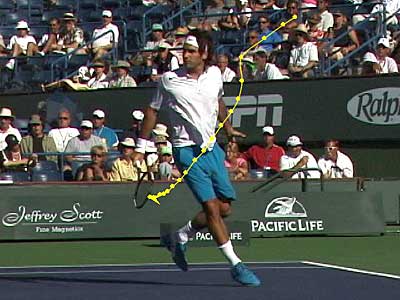|
TennisOne Lessons The Underspin Backhand Down the Line Jim McLennan At one level of competition, you are only as good, only as confident, and only as competent as your second serve. Dodgy second serve, and your play and results are dodgy. Topnotch second serve and your results are stellar. But at another level, often the telling edge between two opponents rests with the backhand. That is, within backhand to backhand exchanges, both players probing for a weakness, the player who blinks, flinches or errs first, gives the edge to the opponent. And in a backhand to backhand crosscourt exchange, the player who can move inside the baseline and take a short ball up the line with an underspin approach will usually rule the day. McEnroe and Rafter had this shot in spades; Roddick’s is still under construction, and Federer is the current maestro. When it comes to mastering the underspin backhand, the “devil is in the details” as they say, so we will focus on the nuances.
Collisions Imagine a tennis ball as it collides with a backboard. A ball that ascends or rises as it meets the backboard will rebound up, and of equal importance, this ball will acquire backspin. Now, imagine your racquet is that stationary backboard. A ball that rises into that racquet will have a tendency to rebound up as well. To counteract that tendency, we swing down on this ascending ball. The question is, “how much down?” The answer is you have to swing down at a steeper angle than the angle of the ascending ball. (To see this, look closely at the Federer video at the end of the article.) But further, if the upward rebound creates its own backspin, and one swings down against this ball, the result is a heavily spinning ball.
That said, when moving inside the baseline, taking the backhand on the rise to play down the line, you are dealing with an up bouncing ball which requires a down swing. Further, in a backhand to backhand exchange, this ball is coming in on a crosscourt line, so threading the needle so to speak down the line requires an extremely accurate stroke. So that is the situation, those are the goals, now let’s explore the feel. Preparation for the underspin backhand includes the following checkpoints. Early shoulder turn, elbow flexed, racquet face well open, body weight initially placed on the back foot. From this spot, the stroke resembles a pulling – where shoulders, arm, forearm and hand pull the racquet down and into the ball. Variants within this stroke include a chip with more of a pronounced down swing, a drive where the racquet moves more horizontally with ever so slight a down hit, and the dropper where the racquet face feathers under the ball imparting more of a spinning hit than a forceful drive. But in each case the initial preparation is identical, the varieties of this stroke occur at the back of the back swing, and specifically, in how much the racquet drops before stroking into the ball.
Carioca footwork Executing the down the line backhand slice: The backhand crosscourt exchange ensues, you note the short ball, now what? First, foremost, and for that matter always, turn the shoulders and set the racquet with the continental grip. Moving forward with your hips initially facing the net, as you approach contact the sequence is right foot, then left foot swinging behind the right foot, then contact, and then the right foot again carrying you toward the net. This Carioca footwork might also be known as the Texas Grapevine step, though I have spent little time on the dance floors of Texas. If you do not execute the carioca step, the shoulders are often too open and the down the line resembles a push. Turning sideways initially will compromise your forward movement as you will be hopping as you approach the ball. So the goal is to glide forward and then make a nifty turn to the side prior to contact to line up the down the line stroke, and then quickly move through the hit and to the net.
Viewing the Master
Preparation Roger is inside the baseline (figure 1), moving forward, fully prepared to take the ball early. The yellow line is the actual incoming flight of the ball with the circle noting the eventual contact point. Note how the line of his shoulders matches the incoming line of the ball, and his hand and racquet are up and also within that line. Body weight is balanced over the back foot and ready to step forward into the hit. This is classical underspin preparation, and though the professionals take the racquet much further back, as Roger did in previous frames, the reference point of the strings facing the ball keys your preparation within the line of flight of the ball. Quiet Wrist and Carioca Step Figure 2, just a few moments after contact, emphasizes Roger's wrist, shoulder alignment, and footwork.
Many a recreational player will drop their wrist through the contact zone, which weakens the shot. I like to think of this, not as a locked but rather a quiet wrist. His non dominant arm shoots backward as he hits through the ball, enabling him to remain sideways and stay on line with the shot. Finally note his left foot beginning to swing behind his forward or right foot. This enables him to move through the ball but at the same time not open up and pull off the line of the shot. Moving Through the Hit and Splitting the Hands Now the carioca step is most noticeable (figure 3). Federer has continued to move forward through the hit and towards the net, but at the same time still sideways to the net. This carioca step must be practiced with every bit the same diligence as the topspin forehand or return of serve. But the payoff, if practiced, will be your mastery of the accurate, forceful, down the line underspin backhand.
Underspin Swing Path The dots (figure 4) are the actual path of the racquet, and at first take this was not what I expected to see. Rather, I imagined more or less a straight downward line from start to finish. Remember, this shot is about finesse and about overcoming the upward rebound of the ascending ball. The stroke starts in a downward path, but at contact the racquet veers sharply down, accentuating both the spin and the intent. Somehow, I believe when we track similar racquet paths for the heavy aggressive topspin forehand, the impact event does not influence the path of the racquet as much as we see here.
Now let’s look at Roger in video McEnroe, Rafter, Edberg, Sampras, and even Fabrice Santoro on the forehand side – I can easily see and or imagine any of these players always looking for the short ball, and once noticed, swooping forward, well inside the baseline, taking the ball early, using the underspin to keep the ball low after it bounces on the opponents side of the net, and equally if not of greater importance using the flight time of the approach to move forward into excellent volleying position. This shot is not about how fast it gets to the opponent but rather that the time it takes to arrive should match the amount of time it would take to move into an offensive volleying position. And the venerable Tom Stow would be pleased to know there are still players who either write about or try to learn how to move in. I f you want to add this shot to your game, I recommend you execute the following contract with yourself – “I will take the net at least twice per game on the opponents second serve, and at least one time per game on the opponents first serve – no matter the score, no matter the situation, no matter what.” At the end of the year the backhand (and forehand) approach as well as the first volley, will be VASTLY improved. I guarantee it! Your comments are welcome. Let us know what you think about Jim McLennan's article by emailing us here at TennisOne.
siliconCOACH Ltd produces a range of sports analysis software designed to analyse motion, enhance performance, and reduce the risk of injury. The video analysis software is now used around the world by athletes, coaches, sports scientists, teachers, podiatrists, physiotherapists, chiropractors, and biomechanists. siliconCoach has many advantages over normal video. For exampl,e you can split a movie frame into two fields. This allows you to view 50 PAL/60 NTSC images per each second of original digital video which is essential to accurately analyse fast or complex movements. siliconCOACH Pro also comes as siliconCOACH Pro Server Edition for multiple users in an institution.
|
|||||||||||||||






